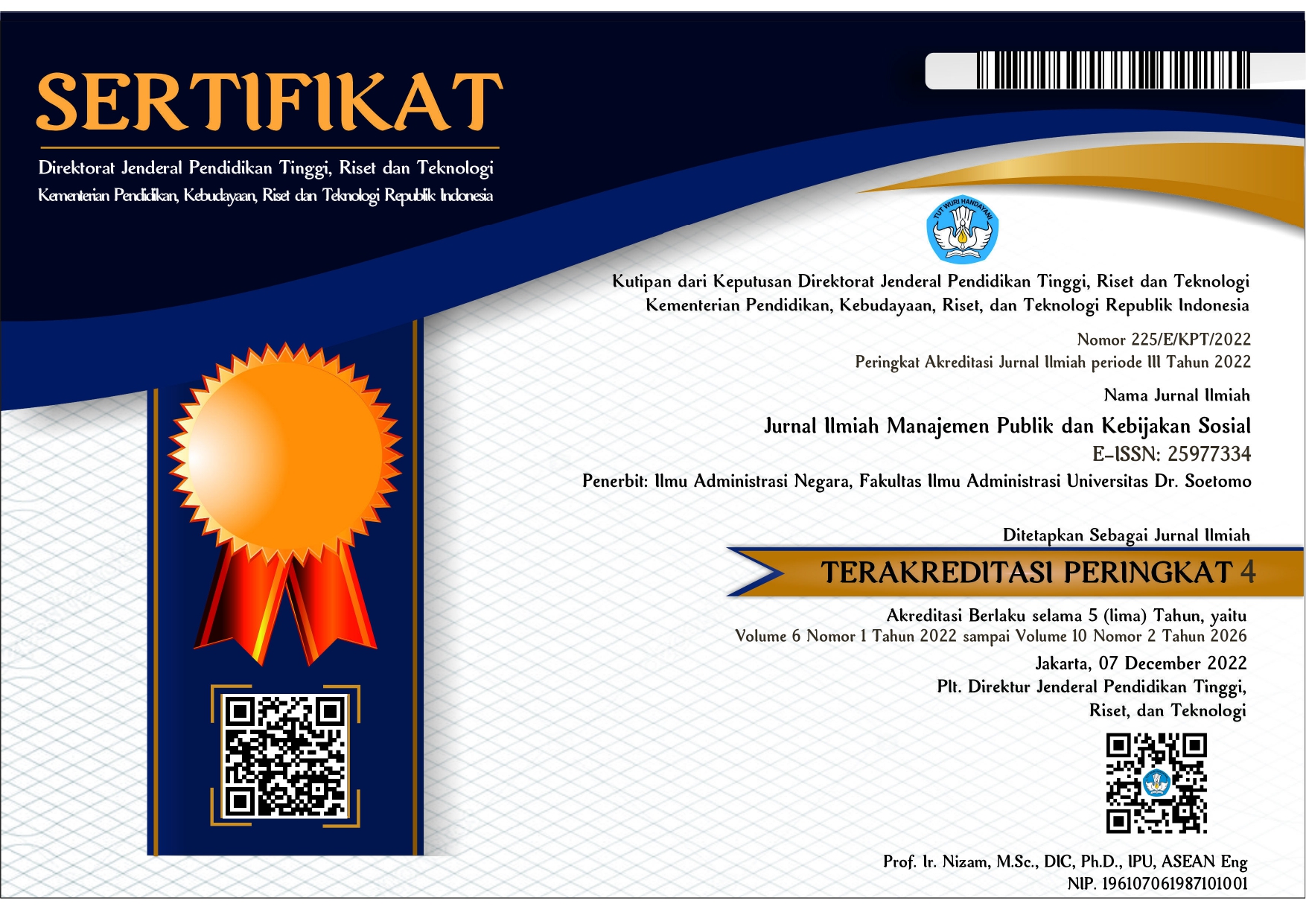Pengaruh Kenaikan Tarif Pajak Pertambahan Nilai Terhadap Perilaku Kepatuhan Pajak Studi Lapangan Pada Kantor Pelayanan Pajak Pratama Cikarang Utara
 Abstract views: 136
,
Abstract views: 136
,
 PDF (Bahasa Indonesia) downloads: 130
PDF (Bahasa Indonesia) downloads: 130
Abstract
Tax revenues provide the largest contribution to the overall revenue of the Indonesian state, In order to increase state revenues from the taxation sector in Indonesia, the government has implemented a policy of raising the Value Added Tax rate from 10% to 11%, which will take effect on April 1, 2022, and increasing the rate again to 12% in 2025. The increase in the VAT rate is considered to be able to affect compliance behavior because it can increase the tax burden that must be paid from the income received by Taxpayers. Therefore, this study was conducted with the aim of determining the effect of the increase in the Value Added Tax rate on the compliance behavior of Taxpayers in fulfilling their Value Added Tax responsibilities. The research was conducted quantitatively with a causality approach to corporate taxpayers registered in the working area of KPP Pratama Cikarang Utara, the sample determination was determined by non-probability sampling with purposive sampling method and 51 respondents were obtained as research samples with primary data obtained from filling out questionnaires online. The independent variable in this study is the increase in Value Added Tax rates and the dependent variable is tax compliance behavior. An analysis of compliance indicators is performed to test changes in compliance behavior, the Wilcoxon Signed Rank Test is used to ascertain the effect of the direction of the increase in Value Added Tax rates on taxpayer compliance, and the Mann-Whitney test is used to assess the effect of the magnitude of the increase in Value Added Tax rates on tax compliance. The results showed that there was no evidence on the behavioral change in tax compliance regarding the increase in the Value Added Tax rate from 10% to 11% and the increase by 12% for Corporate Taxpayers at North Cikarang Tax Office, the results of the analysis of compliance indicators found that respondents tended to comply in implementing the obligation to collect Value Added Tax both before and after the increase in the Value Added Tax rate. At the end, the results of this study are expected to be one of the considerations in making fiscal policy and can be a scientific reference in studies in the field of taxation.
References
Agha, A., & Haughton, J. (1996). Designing VAT systems: Some efficiency considerations. The Review of Economics and Statistics, 303–308.
Allingham, M. G., & Sandmo, A. (1972). Income tax evasion: A theoretical analysis. Journal of Public Economics, 1(3–4), 323–338.
Artavanis, N. T. (2018). Tax evasion and VAT rates: Evidence from a setting with limited tax-shifting. SSRN.
Badan Pusat Statistik. (2023). Realisasi Pendapatan Negara [Laporan Statistik]. Badan Pusat Statistik. https://www.bps.go.id/id/statistics-table/2/MTA3MCMy/realisasi-pendapatan-negara.html
Bidin, Z., & Abd Weheed, N. S. A. (2023). Business Income Tax Compliance Behavior Among Sole Proprietorships In Penang. 6th Limc 2023, 422.
Chan, S. H., & Song, Q. (2021). Implications of tax audit risk, consequences, aggressive behavior and ethics for compliance. International Journal of Accounting & Information Management, 29(5), 823–847.
da Silva, J. G. C. (2022). Experimental research. World Journal of Advanced Research and Reviews, 16(3), 239–256.
Delice, A. (2010). The sampling issues in quantitative research. Educational Sciences: Theory and Practice, 10(4), 2001–2018.
Devos, K., & Devos, K. (2014). Tax compliance theory and the literature. Factors Influencing Individual Taxpayer Compliance Behaviour, 13–65.
GIZ Sector Programme Public Finance. (2010). Addressing tax evasion and tax avoidance in developing countries. [Online]. Retrieved from https://www.taxcompact.net/resource/addressing-taxevasion-and-tax-avoidance-developing-countries. Accessed on July 27, 2016
Hair, J. F., Black, W. C., Babin, B. J., Anderson, R. E., & Tatham, R. (2006). Multivariate data analysis . Uppersaddle River. NJ: Pearson Prentice Hall.
Harju, J., Kosonen, T., & Ropponen, O. (2014). Do honest hairdressers get a haircut? Proceedings. Annual Conference on Taxation and Minutes of the Annual Meeting of the National Tax Association, 107, 1–32.
Harju, J., Matikka, T., & Rauhanen, T. (2019). Compliance costs vs. tax incentives: Why do entrepreneurs respond to size-based regulations? Journal of Public Economics, 173, 139–164.
Hasseldine, J., Kaplan, S. E., & Fuller, L. R. (1994). Characteristics of New Zealand tax evaders: A note. Accounting & Finance, 34(2), 79–93.
Indonesia. Undang-Undang Nomor 7 Tahun 2021 tentang Harmonisasi Peraturan Perpajakan. Lembaran Negara RI Tahun 2021 Nomor 246, Tambahan Lembaran RI Nomor 6736. Sekretariat Negara. Jakarta.
Kemenkeu, B. (2017). Indikator Keberhasilan DJP adalah Tingkat Kepatuhan Wajib Pajak.
Matthews, K. (2003). VAT evasion and VAT avoidance: Is there a European Laffer curve for VAT? International Review of Applied Economics, 17(1), 105–114.
Memon, M. A., Ting, H., Cheah, J.-H., Thurasamy, R., Chuah, F., & Cham, T. H. (2020). Sample size for survey research: Review and recommendations. Journal of Applied Structural Equation Modeling, 4(2), 1–20.
Prananjaya, K. P., Murdiawati, D., Wulanditya, P., & Narsa, N. P. D. R. H. (2023). Keadilan Perpajakan dan Perubahan Tarif Pajak Dalam Meningkatkan Kepatuhan Pajak: Studi Eksperimental. INVENTORY: JURNAL AKUNTANSI, 7(2), 33–48.
Said, L. (2023). Implementation Of Vat Rates According To Law No. 7 Of 2021 And Its Impact On Msme Taxpayers. 6th Limc 2023, 404.
Sauro, J., & Lewis, J. R. (2016). Quantifying the user experience: Practical statistics for user research. Morgan Kaufmann.
Schoeman, A., Evans, C., & du Preez, H. (2021). The Effect of Changes in the Value-added Tax Rate on Tax Compliance Behaviour of Small Businesses in South Africa: A Field Experiment. In Advances in Taxation (Vol. 29, pp. 65–88). Emerald Publishing Limited.
Suzuki, T., & Kawakubo, T. (2022). Are SMEs Avoiding Compliance Costs? Evidence from VAT Reforms in Japan.
Winanto, A., Rahman, R. S., Rinaldi, M., Prawiranegara, G. P., Judijanto, L., Tampubolon, A. S., Muhtarudin, M., Bibiana, R. P., Yuliah, M. E. A., & Suyati, S. (2024). Perpajakan: Teori Komprehensif. PT. Sonpedia Publishing Indonesia.
Yitzhaki, S. (1979). A note on optimal taxation and administrative costs. The American Economic Review, 69(3), 475–480.
Copyright (c) 2025 Repli Kurniawan, Tubagus Ismail, Andi Harmoko Arifin

This work is licensed under a Creative Commons Attribution-ShareAlike 4.0 International License.
Authors who publish with JIMPKS: Jurnal Ilmiah Manajemen Publik dan Kebijakan Sosial agree to the following terms:
-
Authors retain copyright and grant the journal right of first publication with the work simultaneously licensed under a Creative Commons Attribution License (CC BY-SA 4.0) that allows others to share the work with an acknowledgment of the work's authorship and initial publication in this journal.
-
Authors are able to enter into separate, additional contractual arrangements for the non-exclusive distribution of the journal's published version of the work (e.g., post it to an institutional repository or publish it in a book), with an acknowledgment of its initial publication in this journal.
-
Authors are permitted and encouraged to post their work online (e.g., in institutional repositories or on their website) prior to and during the submission process, as it can lead to productive exchanges, as well as earlier and greater citation of published work.









